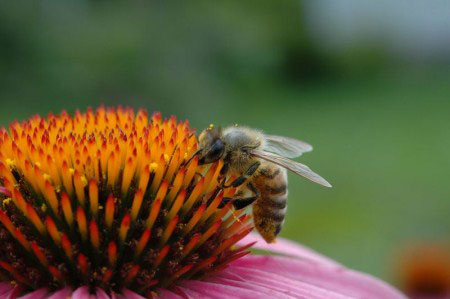Discover the 'honey bee' island in the Sahara
Scientists have discovered honeybee populations of more than 10,000 years old, isolated in an oasis of northern Sahara, the world's largest desert.
Taher Shaibi of Al-Fatah University in TriPoli, Libya has announced a unique discovery in the journal Genetic Conservation. The bees on the species Apis mellifera .
But when scientists studied other bees around the Kufra oasis in Libya, they discovered genetic differences.
The new discovery shows that these bees lived 'isolated' in Kufra 5,000 - 10,000 years ago. The cause is due to climate change that turns a green ancient steppe in the Sahara into an arid desert like it is today.
Analyzing the bees in Kufra, the scientists did not detect the vital signs of Varroa Destructor, the deadly parasite that often lurks in the honey bee world.

The honey bee in the oasis does not contain the Varroa parasite, a world-wide bee killer.
In his article, scientists suggest, Varroa Destructor is the mystery behind the orderly collapse of bee populations around the world. A tenth of the global bee population has left because of this "killer". The most specific is their influence on commercial bee farms in North America and Europe, causing millions of dollars in losses since 2006.
Discovering an extremely important and isolated population of bees and bees, they can be a pure species. Researchers conjecture that Kufra bees may contain a number of genetic traits that may be useful for exporting honey bees worldwide without worrying about spreading germs.
But there is another simple reason given, Kufra was never exposed to the common pathogens of commercial bee populations, so they are still healthy and different. They may have anti-disease antigens that scientists have not found. Scientists hope, a careful breeding program between Kufra bees and commercial bees can bring surprising results.
Source: Discovery
- The arid Sahara desert used to be the place where the largest marine creatures lived
- How effective is it to use honey?
- How is honey formed?
- Found rare sahara newspaper
- 5 best times to drink honey
- Found the true age of the Sahara desert?
- The wild world on the Sahara desert
- Honey is good for health but it must be noted that this will not kill
- Little known facts about the Sahara desert
- Could it be that humans have turned the Sahara into a desert?
- How to recognize real honey, fake honey
- Learn more about the effect of honey
 Why do potatoes have eyes?
Why do potatoes have eyes? 'Tragedy' the world's largest carnivorous life: Death becomes ... public toilet
'Tragedy' the world's largest carnivorous life: Death becomes ... public toilet Tomatoes were once considered 'poisonous' for 200 years
Tomatoes were once considered 'poisonous' for 200 years Detecting microscopic parasites on human face
Detecting microscopic parasites on human face How to identify bee species and how to treat stings
How to identify bee species and how to treat stings  Interesting discovery: Bees 'shake hands' with each other to play with Lego
Interesting discovery: Bees 'shake hands' with each other to play with Lego  What should you do when attacked by bees?
What should you do when attacked by bees?  Discover things you may not know about bees
Discover things you may not know about bees  How unmatched are hornets when just 30 of them are enough to 'clean up' 30,000 honey bees in just 3 hours
How unmatched are hornets when just 30 of them are enough to 'clean up' 30,000 honey bees in just 3 hours  You may not know: Queen bumblebees can live underwater for a whole week
You may not know: Queen bumblebees can live underwater for a whole week 